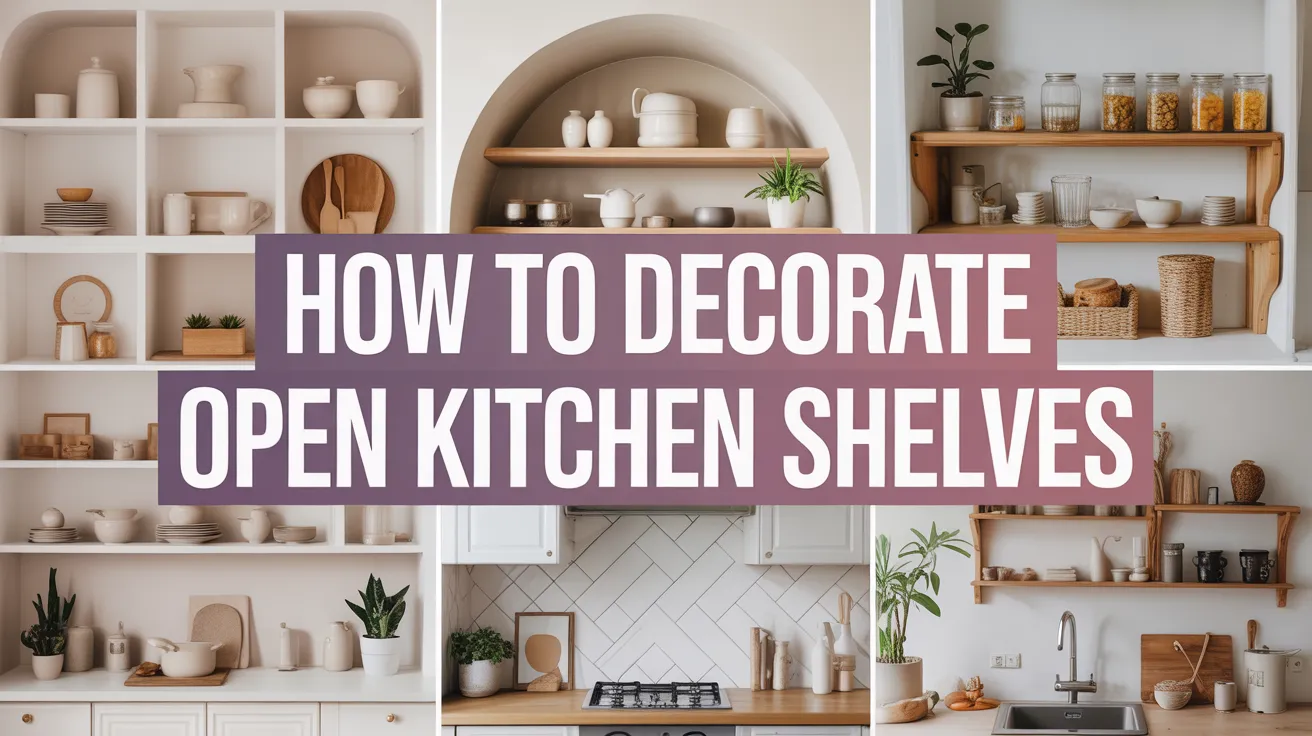How to Decorate Open Kitchen Shelves for a Stylish and Functional Look
Open kitchen shelves offer a great way to showcase style while keeping essentials within easy reach. Decorating open shelves is about balancing function and beauty by combining useful items with decorative pieces to create a fresh and inviting look. With the right approach, shelves can transform a kitchen into a space that feels organized and personalized.
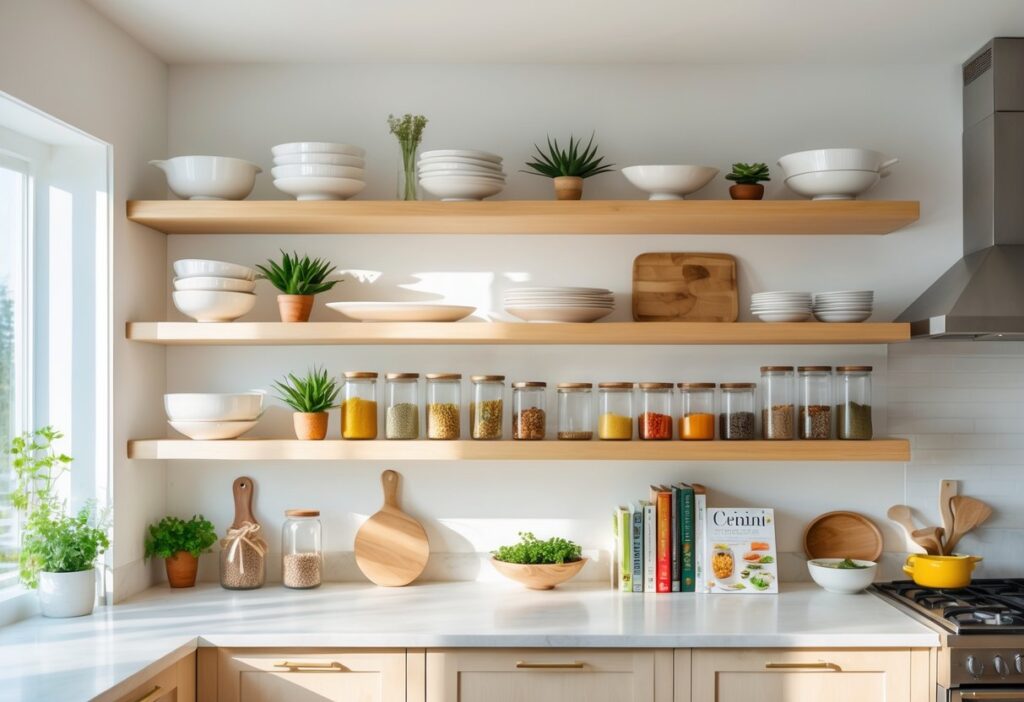
To decorate open kitchen shelves effectively, it helps to mix textures, colors, and shapes. Displaying everyday items like dishes and glassware alongside plants, cookbooks, or small art pieces adds interest without clutter. Thoughtful organization ensures the shelves stay practical and visually appealing.
Adjusting your shelf decor seasonally or when tastes change keeps the kitchen lively and current. A clear plan for shelf style and thoughtful arrangement can make open shelving a standout feature that enhances both storage and style in any kitchen.
Key Takeaways
- Planning shelf layouts improves both use and look.
- Combining useful items with decor keeps shelves attractive and practical.
- Regular updates help shelves stay fresh and organized.
Planning Your Open Kitchen Shelves
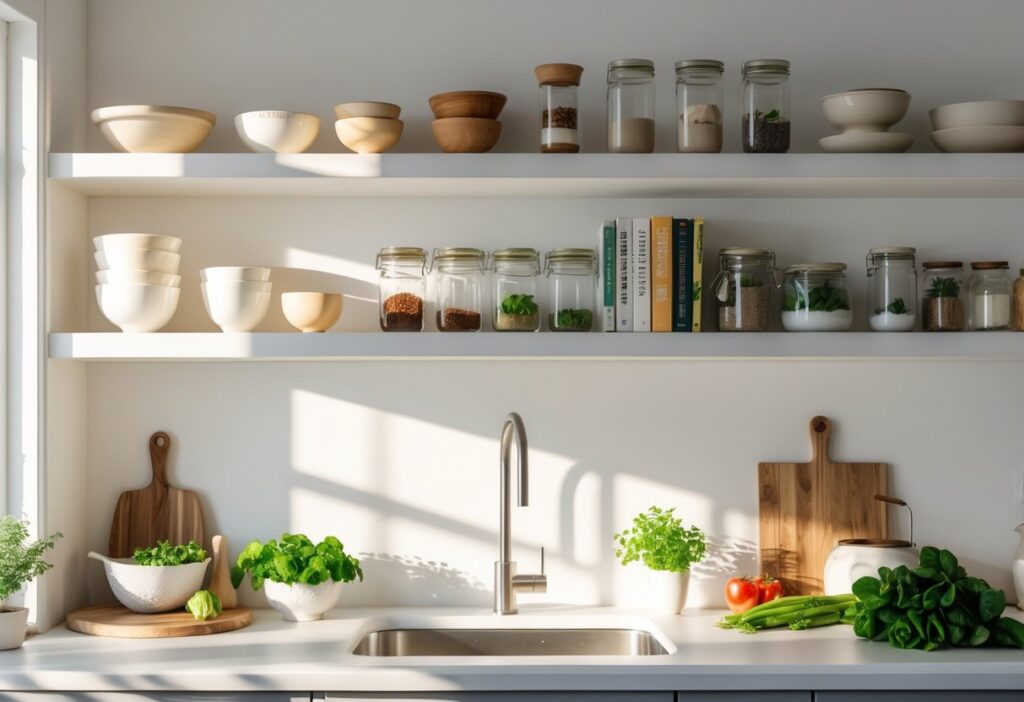
Careful planning is key to making open kitchen shelves both functional and attractive. It involves understanding the kitchen’s layout, selecting the best spot for shelves, and accurately measuring the area to fit your needs.
Evaluating Your Kitchen Layout
Before installing open shelves, the user should look at the kitchen’s flow and current storage. Identify which areas see the most cooking activity and could benefit from easy-to-reach shelves. Shelves near the stove or prep area are practical for keeping frequently used items handy.
They also need to consider how the new shelves will interact with existing kitchen cabinets and appliances. Will the shelves block natural light or make the space feel cramped? The goal is to enhance usability without cluttering the kitchen.
Choosing the Best Location
Choosing where to place open shelves depends on daily routines and available wall space. Walls with no cabinets above the countertop are ideal as they can hold dishes, spices, or glassware while keeping counters clear.
It’s important to avoid placing shelves too close to the stove where grease buildup would be an issue. Instead, spots near the sink or dining area often work well to display decorative pieces or hold everyday items.
Measuring for Shelf Placement
Accurate measurements ensure shelves fit the space and meet storage needs. Measure the width and height of the wall space available, keeping at least 12 to 16 inches of clearance between shelves to fit plates and bowls.
Consider shelf depth carefully; 10 to 12 inches is standard and works well with most kitchen items. Record these dimensions before buying or building shelves to avoid costly mistakes.
Selecting Materials and Shelf Styles

Choosing the right materials and styles for open kitchen shelves affects both the look and function of the space. The material influences durability and vibe, while the style impacts how the shelves hold items and blend with the kitchen. Knowing the differences helps pick frames that fit the kitchen’s needs and design.
Wood Versus Metal and Glass
Wood shelves bring warmth and a natural feel to kitchens. They are sturdy and can hold heavy dishes and cookware well. Different types of wood offer varied colors and grains, which add character. Wood can be painted or stained to match the kitchen’s palette.
Metal shelves are strong and often give a modern or industrial look. They handle moisture better than wood and are easy to clean. Glass shelves feel lighter and more open but are less durable. They suit kitchens where glassware display and a sleek feel are priorities.
Key material traits:
Wood – Durable, warm, and versatile. However, it can be heavy and requires care. Best suited for traditional and rustic styles.
Metal – Strong, sleek, and moisture-resistant. It may look cold but works well in industrial and modern styles.
Glass – Light, open, and elegant. Fragile and shows dirt easily, but fits perfectly in contemporary and minimalist styles.
Floating Versus Bracketed Designs
Floating shelves attach directly to the wall without visible supports. They offer a clean, modern look and make the kitchen feel more open. Because of their hidden fixings, they need strong anchors to hold weight but work well for smaller items.
Bracketed shelves use visible metal or wood supports, which add a design element and extra strength. Brackets can be simple or decorative, contributing to the kitchen’s style. This style suits heavier items and kitchens that want added character from hardware.
Choosing between floating or bracketed depends on weight needs and the desired look. Floating shelves create minimalism; bracketed shelves add boldness and support.
Integrating Floating Shelves and Wood Shelves
Combining floating shelves with wood materials balances beauty and function. Wooden floating shelves maintain a clean look while showing natural texture and warmth. This style blends modern design with the comfort of organic materials.
This integration works well in open kitchen shelves where space feels limited, but heavy-duty storage is still needed. Wood floating shelves can hold cookware or dishes securely while adding softness compared to metal or glass.
Using wood in floating designs allows for custom sizes and finishes, fitting both small and large kitchens. It also offers easy installation and a stylish, subtle way to organize kitchens without bulky fixtures.
Styling and Decorating Open Kitchen Shelves
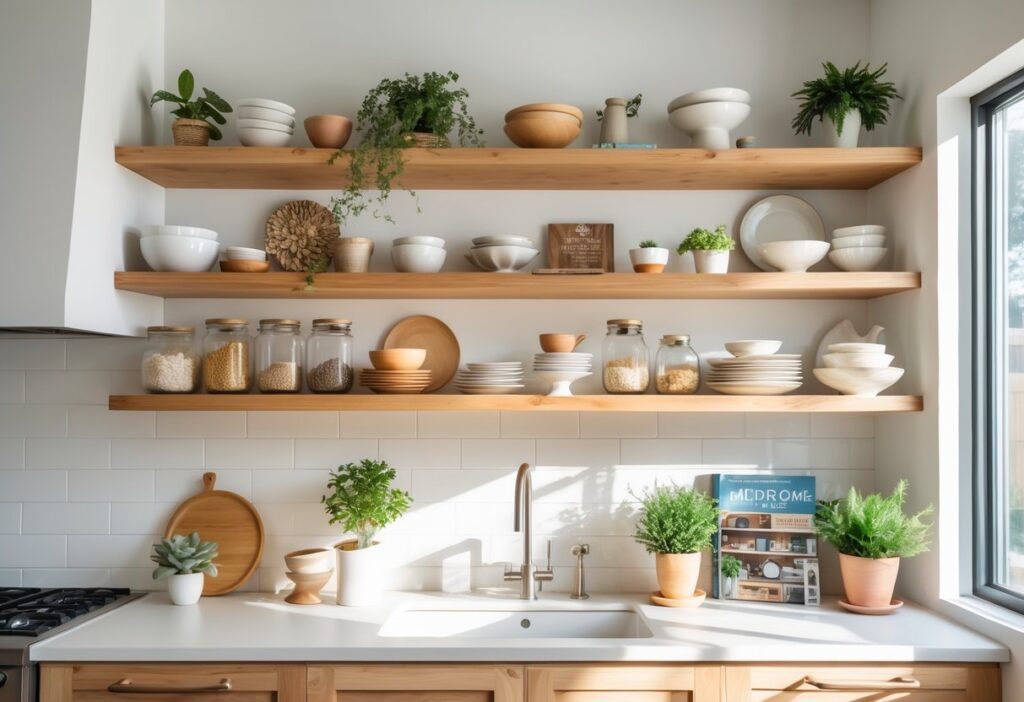
Open kitchen shelves need a careful balance between looking good and being practical. Arranging dishes and glassware, mixing decor with everyday items, playing with color and seasonal accents, and adding natural touches all help make shelves stylish and useful.
Arranging Everyday Dishware and Glassware
Everyday plates, bowls, and glasses are the base of open shelves. Items should be grouped by type for easy use. Stacking plates creates clean lines, while arranging glasses in rows keeps the look tidy.
Display frequently used items at eye level for convenience. Larger items like serving bowls or pitchers work well on lower shelves.
Using matching or similar dishware helps create a cohesive look. Mixing different patterns can work but should feel balanced, not cluttered. Keeping plates, mugs, and glasses visible but organized keeps kitchen decor fresh and functional.
Mixing Decorative and Functional Items
Blending decorative pieces with practical items makes open shelves both attractive and useful. Cookbooks, interesting jars, or small bowls can sit alongside mugs or trays.
Group items in sets of three or five for visual appeal. Use clear jars for pasta or spices to add interest and keep ingredients handy. Decorative plates or pottery add personality but avoid overcrowding.
Balance is key. Leave some space empty to prevent shelves from looking too full. This mix pulls together kitchen decor while keeping shelves ready for daily cooking and dining needs.
Incorporating Color Schemes and Seasonal Decor
Choosing a color theme helps the open shelves feel planned and stylish. Neutral tones with pops of color are popular choices. For example, white dishes paired with blue accents create a calm, clean feel.
Seasonal decorations like small pumpkins in fall or bright flowers in spring bring freshness without overwhelming the space. Switch items monthly or quarterly for easy updates.
Use color carefully. Too many bright pieces can look busy. Instead, focus on a few colors that complement your kitchen and balance them with neutral tones for a polished look.
Adding Greenery and Natural Elements
Green plants and natural textures soften open shelves and introduce life to the kitchen decor. Small potted herbs are practical and decorative. Succulents or hanging plants add variety in height and texture.
Wooden bowls, wicker baskets, or stoneware complement greenery and enhance a natural feel. Use plants that thrive in kitchen conditions, such as low light or higher humidity.
Natural elements create warmth and break up the look of plates and glassware. Group plants and natural objects in clusters to make an interesting, balanced display.
Organization and Practical Tips

Organizing open kitchen shelves well helps keep the space both useful and attractive. Clear grouping, thoughtful placement, and smart storage choices improve access and reduce clutter in the kitchen.
Creating Visual Balance
Visual balance means arranging items so the shelves look even and inviting. Use a mix of shapes and sizes, such as tall jars next to stacked plates or bowls. Avoid placing all heavy or tall items on one side, which can feel uneven.
Grouping similar colors or materials also helps. For example, white dishes paired with clear glass containers create a clean look. Leave some empty space between groups to prevent overcrowding.
Vary heights and layers by placing smaller items in front or stacking where safe. This stops the shelves from feeling flat or monotonous.
Sorting by Usage Frequency
Items used most often should be easy to reach on open shelves. Place daily dishes, cups, or cooking tools at eye level or lower for quick access.
Less-frequently used items, such as special cookware or seasonal pieces, can go on higher shelves. This keeps everyday essentials in plain sight and less-needed items out of the way.
Organizing by usage also reduces the time spent searching. It makes the shelves serve their practical role while still looking tidy.
Using Baskets and Containers
Baskets and containers help keep small or loose items grouped and neat on open kitchen shelves. Use baskets to hold things like spices, utensils, or snack packets.
Choose containers that complement the kitchen style, like wicker baskets for rustic looks or clear plastic boxes for modern kitchens. Labeling containers adds clarity and speed when finding items.
Stackable containers maximize vertical space and reduce visual chaos. This method also protects contents from dust, keeping the shelves clean and orderly.
Maintaining and Updating Open Shelves
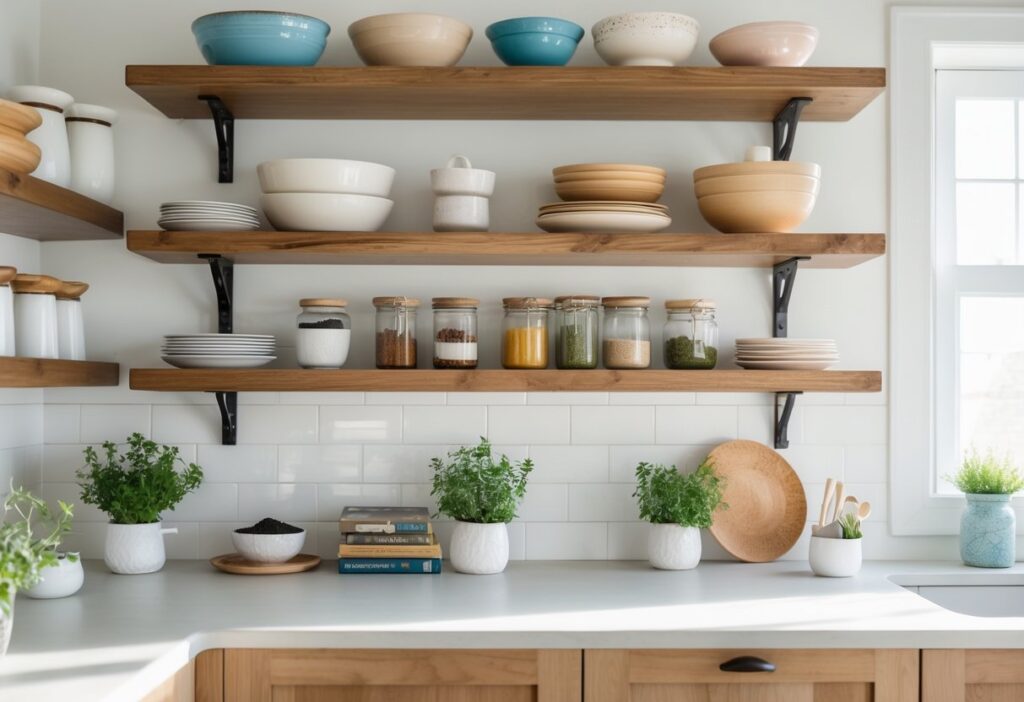
Open kitchen shelves need regular care to keep them looking neat and stylish. Keeping shelves clean and organized helps maintain their function and beauty. Changing the items on display prevents clutter and keeps the space fresh.
Cleaning and Care Guidelines
Kitchen open shelves tend to gather dust and grease quickly because they are exposed. Wiping shelves with a damp cloth once a week helps keep them clean. Use a mild dish soap mixed with water to remove any grease or food stains.
Avoid harsh cleaners that can damage the shelf material or finish. Dry shelves thoroughly to prevent moisture damage, especially if they are made of wood.
Regularly check for loose brackets or hardware and tighten them to keep shelves safe and secure. For glass or metal shelves, use products designed for those surfaces to maintain shine without scratches.
Rotating Displays and Avoiding Clutter
To keep open shelves attractive and functional, it is important to avoid overcrowding. Items should be rotated every few months to give the shelf a fresh look.
Use grouping by size, color, or function to make displays orderly. Leave enough space between items to prevent a cluttered feeling.
Keep often-used items within easy reach and store less-used items elsewhere. Occasionally, remove seasonal decor or items that no longer fit the kitchen style. This keeps kitchen shelves tidy and visually appealing over time.
Conclusion
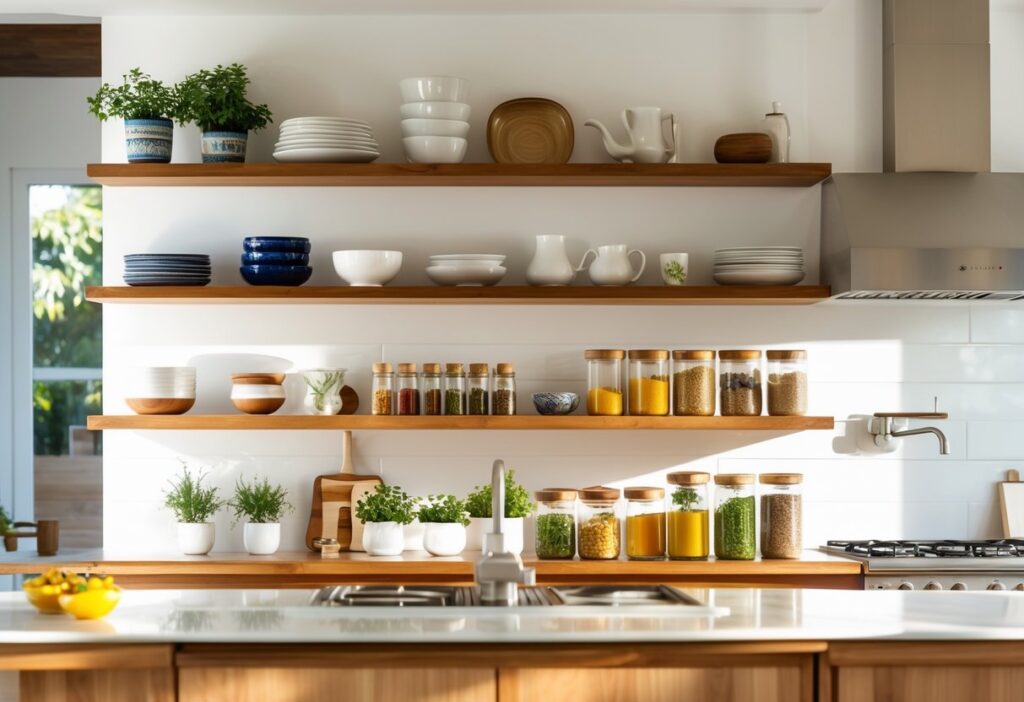
Decorating open kitchen shelves requires a balance between style and function. It helps to mix practical items with decorative pieces to keep the space useful and attractive.
Using varied heights and grouping similar items creates a neat look. Adding small plants or artwork can bring freshness without clutter.
Leaving some empty space is important. It prevents shelves from looking overcrowded and makes the arrangement easier on the eyes.
Tips for success:
- Use containers to organize smaller items
- Choose colors that match the kitchen’s theme
- Experiment with different layouts to find what works best
By carefully selecting and arranging items, open shelves can enhance the kitchen’s feel. They can make the room more open, bright, and inviting while keeping essentials within reach.

